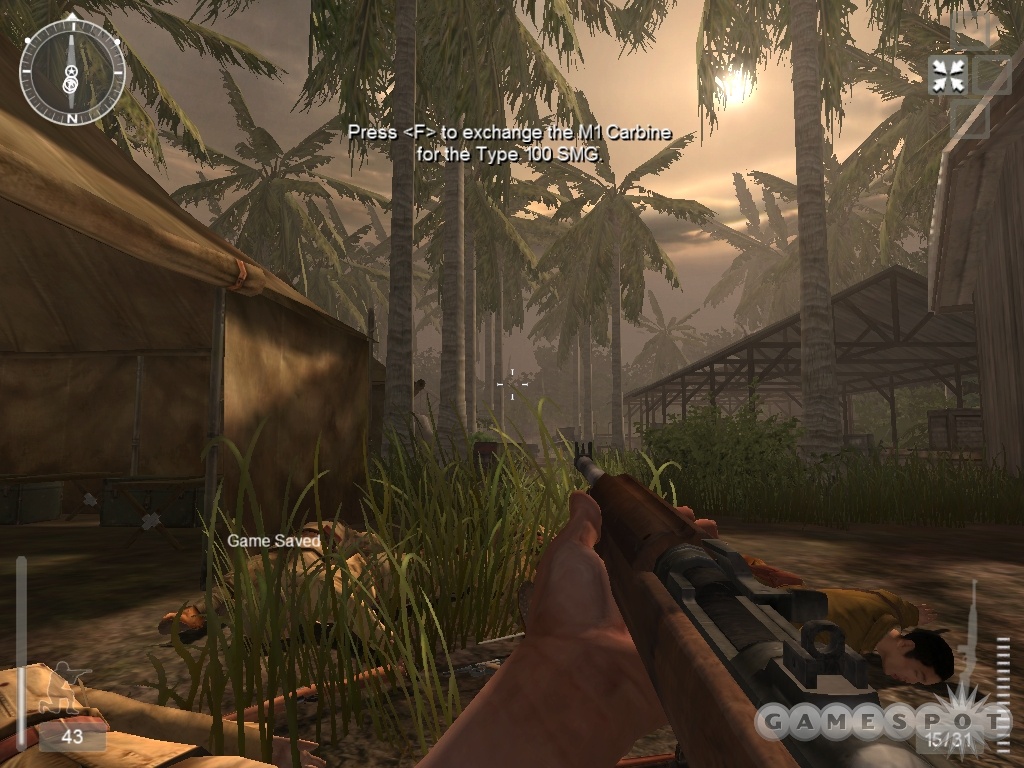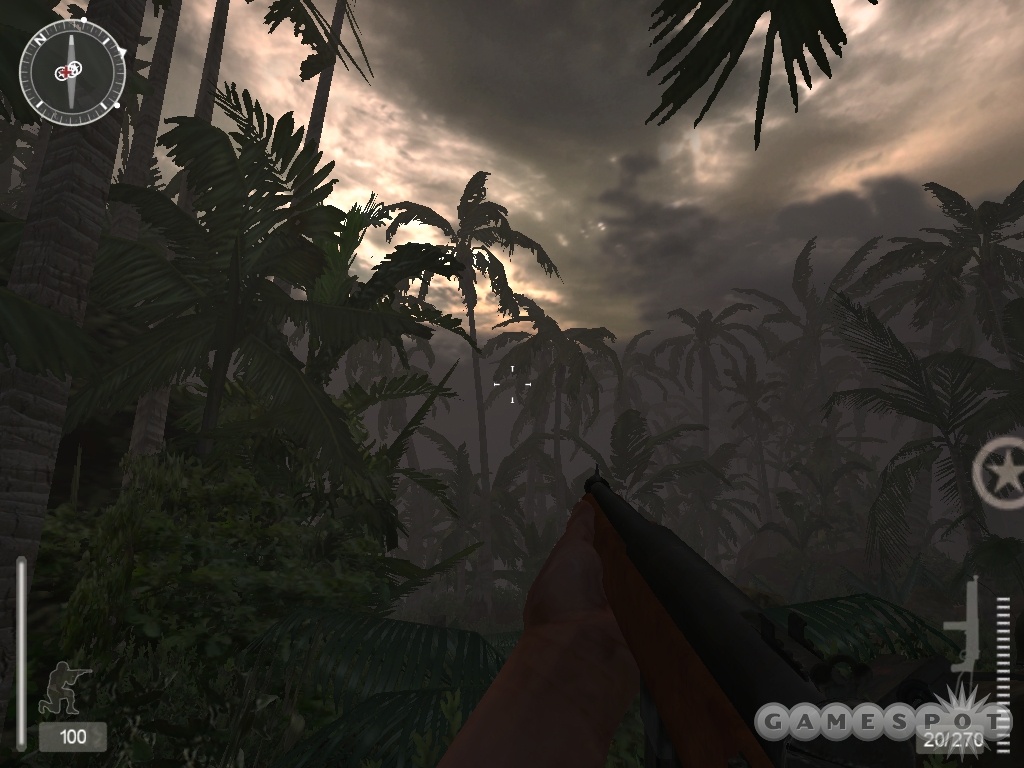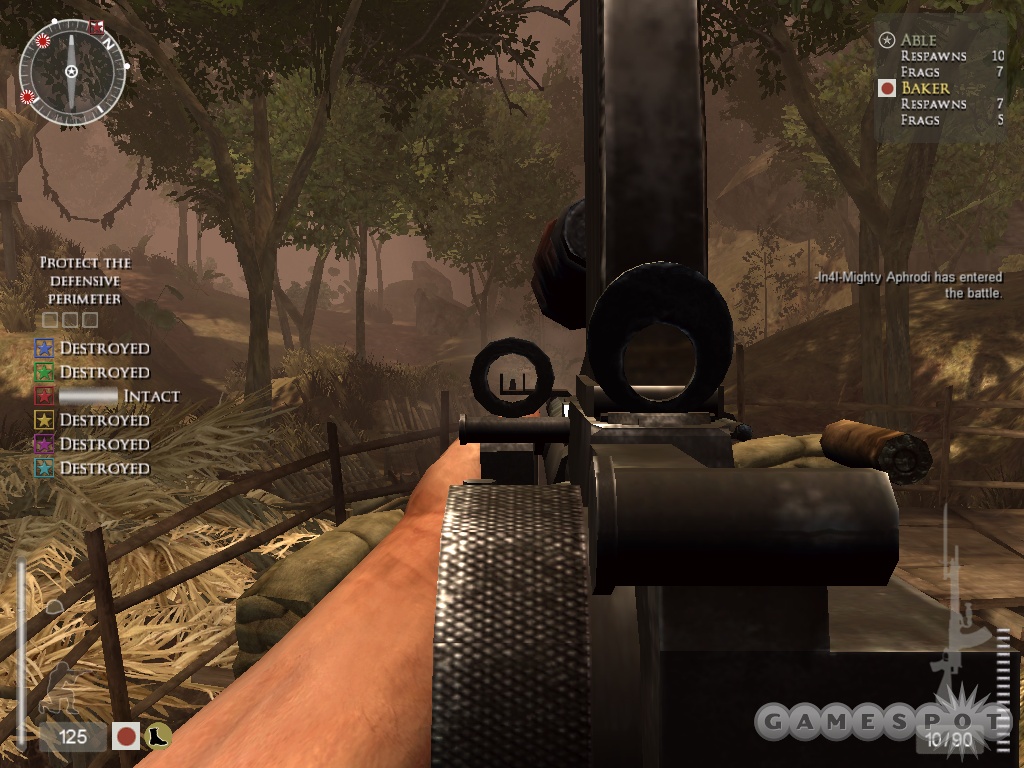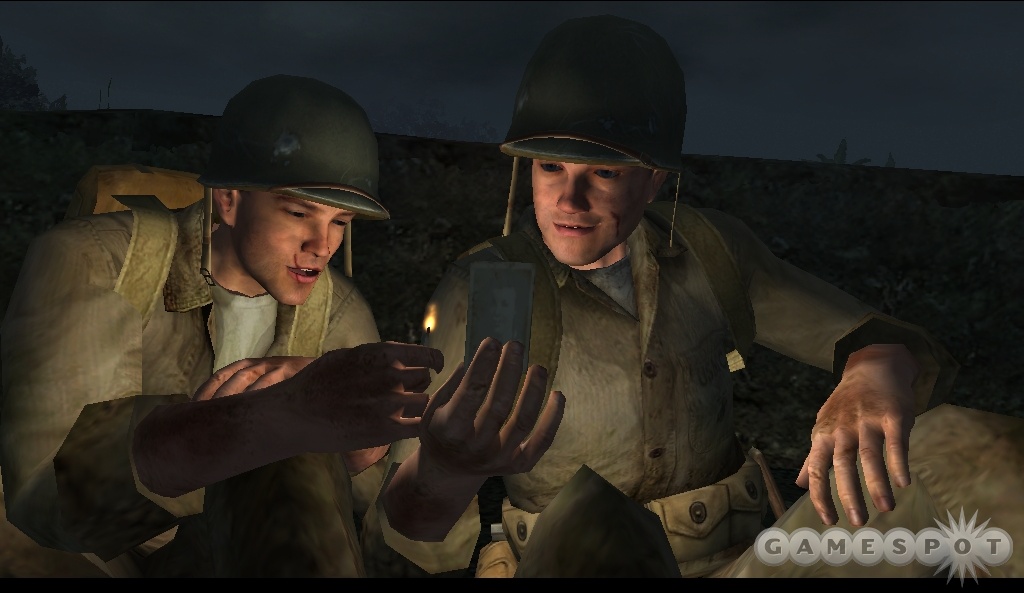Nearly three years ago, Electronic Arts brought its Medal of Honor series of World War II-themed first-person shooters to the PC in Medal of Honor Allied Assault, and that game went on to become highly influential. By combining intense run-and-gun shooting action with an incredibly authentic atmosphere and some spectacular set-piece battles, Allied Assault helped establish the genre's current high standards. Seemingly countless other historic war-themed shooters have been released since then, so it's become very difficult for such a game to distinguish itself...or even compete. Nevertheless, developer EALA was apparently up to the challenge with Medal of Honor Pacific Assault, which takes the series into the Pacific theater of WWII and once again delivers some intense and challenging firefights in its single-player campaign, while also offering a solid multiplayer component for the long haul. Pacific Assault has a few rough edges (long loading times, chiefly among them) and is demanding of even today's fastest PCs, but it ultimately succeeds at delivering a Hollywood-style World War II experience, and it also features a few unique twists.

Pacific Assault features a good-sized single-player campaign consisting of roughly two dozen missions, which will take you 10 or so hours to fight through at the game's default difficulty setting. Whereas Allied Assault clearly drew inspiration from Saving Private Ryan, Pacific Assault kicks off with an ostentatious bang straight out of Pearl Harbor and proceeds to deliver some tense, cutthroat action sequences (juxtaposed with a few thoughtful story bits designed to make the game's characters seem more human) reminiscent of The Thin Red Line. Throughout the game, you'll play as a Marine named Tommy Conlin, and you'll fight together with the rest of his squad. As Conlin, you'll get to wield a variety of authentic Allied and Axis WWII-era weapons, ranging from pistols to light machine guns, and you'll be able to issue some basic orders to your squad. At one point, you'll get to fly a plane. But, for the most part, you'll be stalking through dense jungle underbrush while hoping to get a drop on your enemies before they do likewise. Your foes will often literally come out of the woodwork, attacking you in waves and sometimes charging you savagely with their bayonets. They're consistently daunting foes--and not just because they'll constantly have greater numbers. They'll take advantage of cover, flush you out with grenades, and seem to work in tandem to defeat you.
The campaign occurs during the course of several years, which gave the designers license to change some of the weapons, outfits, and settings from mission to mission. Pacific Assault starts off slowly, with a drawn-out training sequence and sort of a guided tour of Pearl Harbor (leading up to Japan's surprise attack), but afterwards, the game's action mostly stays hot. You'll operate in such places as Guadalcanal, Makin Atoll, Tarawa, and more. These tropical settings and the fearless Japanese soldiers you'll be facing in each of them stand in sharp contrast to the ravaged European countryside of Allied Assault and most WWII shooters. Ironically, though, the setting doesn't feel all that different from that of the recent glut of Vietnam-based shooters, so when you're rustling through the underbrush with a Thompson in hand, looking for any signs of your hidden foes, it's actually easy to forget that this is World War II. Nevertheless, Pacific Assault does a great job of rendering lush, tropical environments and the dangers they may conceal. The game's levels are laid out in a pretty linear fashion, but they do effectively create the illusion that they're densely wooded, sprawling battlefields instead of the easy-to-navigate first-person-shooter levels that they are.
Probably the most interesting twist to Pacific Assault is how it forces you to recover your health from the inevitable injuries you'll sustain, as well as the unique way in which it, like any action game, inevitably kills you off. In previous Medal of Honor games, you scavenged canteens and health packs in each of the levels, but now, most levels offer no such recourse. Instead, you'll be completely dependent on your squad's corpsman to keep you alive. Basically, you can summon him several times per level to completely restore your health. He'll apply some gauze or give you a little shot of something, and before you know it, you'll be back on your feet, good as new.
Recovering from gunshot wounds in this fashion really isn't much more realistic than doing so by walking over a canteen, but it adds an element of tension to the game's battles. Strangely enough, none of your squadmates can actually be killed, but your corpsman may already be preoccupied with tending to one of them when you desperately need his help, so the game encourages you to try to keep your squad safe. However, it doesn't force you to babysit your squad, either. These guys can fend for themselves and will often help you survive some of the more grueling shoot-outs. Also, should you run out of health in Pacific Assault, it's not necessarily the end of you. Your corpsman will sometimes miraculously show up in the nick of time to bring you back from the brink of death. Alternatively, sometimes the last thing you'll see is a Japanese soldier finishing you off, execution-style. Other times you'll just black out to the tune of some old wartime memory.
All this stuff is done quite well, though at times, it's a little awkward. For instance, you might get executed by an enemy soldier even when you're right next to squadmates who could have defended you, or, oppositely, the corpsman might magically appear even when you've been completely overwhelmed. But if nothing else, this system is different from what you're probably used to seeing in other shooters--and it works well enough--so it's a nice change of pace.

Overall, the campaign is actually quite hard. In later scenarios, you can look forward to frequently getting mowed down by enemy machine gun fire, if not from mounted gun emplacements, then from squadrons of Zeros making your life miserable from the sky. What mitigates the difficulty, much like in most single-player shooters, is the ability to quicksave your progress indiscriminately. Being able to restore your progress from any point is certainly convenient, but it also undercuts some of the suspense. Nevertheless, it's what keeps Pacific Assault from being punishing.
Higher difficulty levels, including a "realistic" one that takes away all onscreen indicators (such as your health and ammo indicators, in addition to your weapon crosshairs), encourage you to revisit the campaign missions. Furthermore, some optional mission objectives and the ability to earn medals for completing these and other significant feats might compel you to come back to the game's several tours of duty, especially since the enemies you'll face in Pacific Assault--as well as the soldiers you'll always be fighting alongside--exhibit some fairly impressive artificial intelligence, which results in some flashes of brilliance that offset the occasional AI fluke. Consequently, battles don't tend to play out in a purely scripted fashion. The game does tend to encourage a specific approach to surviving its sometimes difficult firefights, insofar as a direct attack will often get you killed, whereas you'll often find your enemies' flanks conspicuously exposed. Nevertheless, Pacific Assault does a good job of requiring you to play skillfully rather than just making you take a trial-and-error approach until you get it right. Most of the weapons you'll use demand precision, and most of them are also slow to reload; and, unlike in Allied Assault, ammunition can be pretty scarce here, so you'll constantly feel the need to make your every shot count, in addition to using cover and moving while crouched or prone. This is true of the game's multiplayer portion as well.
Pacific Assault's multiplayer mode includes three game types: free-for-all, team deathmatch, and invader. The former two are conventional and pretty straightforward, while the third one obviously got most of the attention from the game's developer. It's an objective-based game type, much like that of Return to Castle Wolfenstein's multiplayer, and it pits American forces against Japanese forces on eight different maps--each with its own specific multitiered mission that places either the Axis or the Allies on offense while placing the other side on defense. One side needs to accomplish a series of sequential objectives, such as demolishing some gun emplacements, retrieving some documents, or radioing back to headquarters, while the other side needs to try to prevent all this from happening. An onscreen radar display and other visual indicators help direct you to where the action is at any given moment, and audio cues will also keep you updated on the mission objective. These features greatly help you get your bearings quickly rather than force you to spend a lot of time learning the flow and layout of each map (while possibly becoming a liability to your team).

Furthermore, Pacific Assault's multiplayer game browser lets you automatically jump into a match without having to sift through a server list, and it also provides a helpful step-by-step system for setting up your own game. Depending on the server, up to 32 players can have at it in any of the game's rather large, complex maps, but we encountered some mixed results in terms of online performance. We experienced occasional patches of severe lag even on some low-ping servers with few players in them, but we also experienced some perfectly smooth sessions with relatively larger populations of players. As is usually the case with online games, your mileage may vary.
At any rate, much like in the single-player portion of the game, the feel of the action online falls a bit short of being perfectly smooth and responsive--but it's still good. There's a solid combination of close-range, in-your-face shooting (and bayoneting!) to be found in Pacific Assault, along with some long-range sniping and plenty of medium-range action involving rifles. Likewise, the maps each seem to offer a good balance of different environments--and therefore different tactical opportunities. So as the flow of the battle moves from one objective to the next, you'll naturally need to change your strategy (and you'll need to try to coordinate with your team accordingly), which makes Pacific Assault's invader mode quite complex and entertaining overall, even if it lacks the drivable vehicles and massive scale of other popular war-themed multiplayer shooters.
As mentioned, Pacific Assault does have some rough edges that somewhat detract from the overall experience. For one thing, the game sports some noticeably long loading times (sometimes around a minute or so) going into either the single-player levels or the multiplayer maps. You'll experience these loading times regardless of how fast your system is or the detail settings you've opted to use. Even the process of quick-loading a game during the campaign missions takes a little while. The game has some pretty buggy behavior at times, too. You'll occasionally see both the friendly and enemy AI doing something completely crazy, or maybe you'll see soldiers clipping through solid walls or something to that effect. Also, you'll hear your squadmates utter the same phrases over and over during the course of the campaign, which is irritating. One particularly off-putting type of comment your squadmates will make involves congratulating you on your good aim. They'll compliment you seemingly way too often, and, at times, they'll do so when there's no way anyone could have seen your enemy drop but you. On other occasions, the game will just kill you off seemingly without explanation, so during some of the more intense battles, it can be confusing to tell exactly where the danger's coming from. Finally, the game's flying sequence is a pleasant change of pace, but the first-person shooter controls are pretty clunky for steering an aircraft. You'll be relieved when the mid-air mission finally ends.
With all that said, it bears repeating that Pacific Assault really does a great job of creating a believable atmosphere, even if the gameplay itself, as well as your allies' inabilities to die or shut up, isn't realistic. The game's proprietary graphics engine shines on a high-end system, and it features some excellent special effects, including how your vision will blur from all the rattling as you fire a mounted machine gun or how your vision begins to fade when you're near death. Character and weapon models also feature high levels of detail and exhibit mostly very good animation. Additionally, there are a lot of nice touches in the environments. You'll spot some indigenous animals in the rustling trees, and bullets seem to rip into most of the different types of surfaces in the game. Realistic weather effects will also influence battles. For instance, it becomes all the more difficult to spot your foes when there's a thick layer of fog or smoke hanging in the air. There's a good physics model here, too, which is at its most striking in the levels in which you'll be fighting in a riverbed. Here, the corpses of your slain enemies will drift downstream, perhaps to warn the enemy of your forthcoming arrival. But as mentioned, Pacific Assault's visuals do come at a price, because the game's frame rate and loading times can leave something to be desired even on fast machines. Meanwhile, the game's more notable effects simply aren't available on lower-detail settings.

The Medal of Honor series has always been known for its exceptionally good audio, and Pacific Assault doesn't disappoint in this regard. The repetition of your allies' chatter is a bit of a shame, but the dialogue itself, including Tommy Conlin's own (you'll actually hear him speak, unlike previous Medal of Honor protagonists), is delivered well; the authentic Japanese spoken by your enemies is especially good. The weapon effects and explosions constantly heard throughout the game are also convincingly loud and clear, along with subtler notes, like how your footsteps cut through the different types of terrain you'll traverse. And, of course, Pacific Assault features an impressive military orchestra soundtrack befitting a World War II epic, and it kicks in at opportune times during the campaign. In a nice touch, the game's menu system is set within a makeshift allied base, where you'll hear various late '30s and '40s-era radio broadcasts that include news, commercials, and music.
There are two different retail versions of Pacific Assault, the more expensive of which shipped earlier on a single DVD-ROM and includes a few documentary-style extras suitable for those interested in learning more about what actually happened when the Americans and Japanese fought in the Pacific more than 60 years ago. Nevertheless, the Medal of Honor series has generally done a good job compromising between historical accuracy and entertaining, nail-biting action, and Pacific Assault continues this tradition. It can be difficult to reconcile how, exactly, such a grim event as World War II could become the context for a fun-filled action game, but it's once again made for an exciting experience in Medal of Honor Pacific Assault.